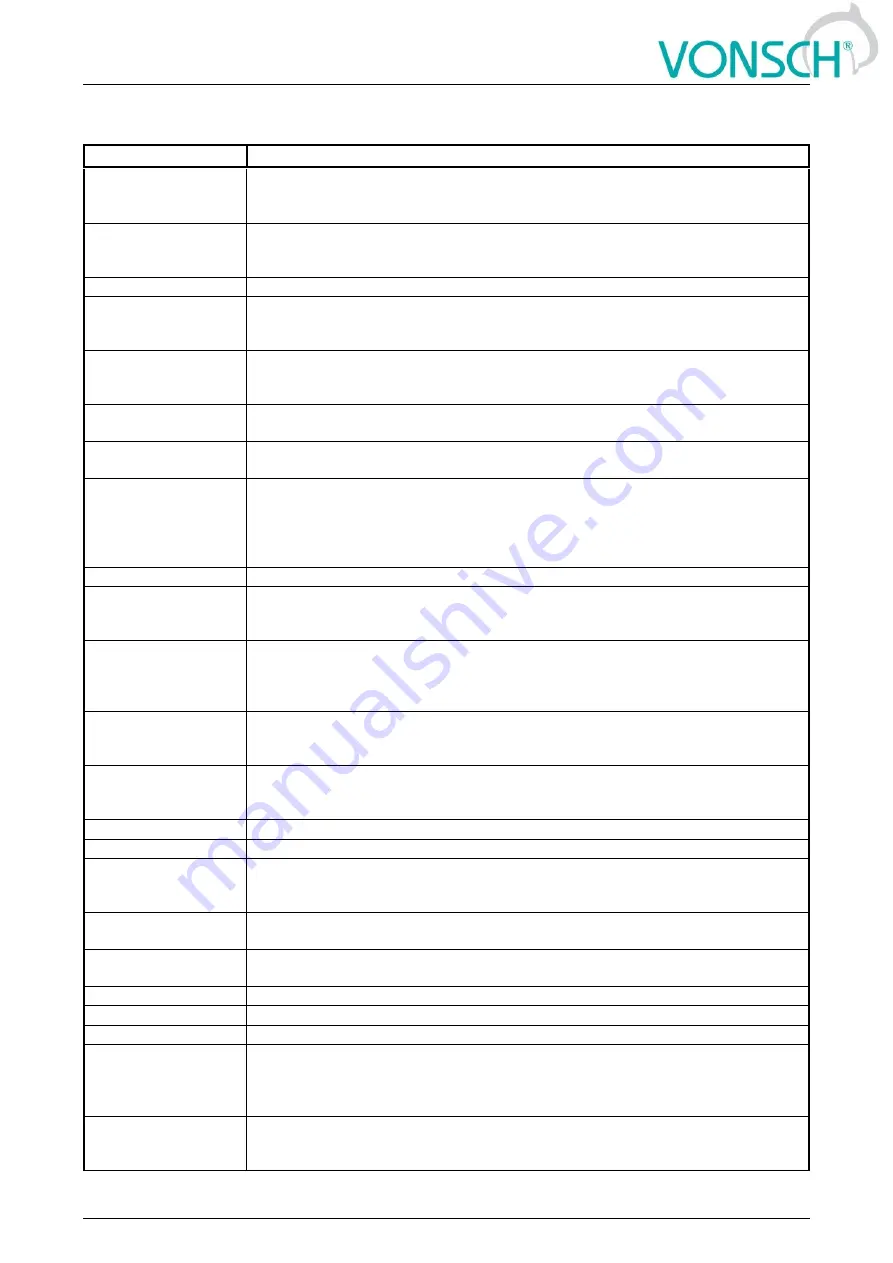
UNIFREM v.3.41x
10 May 2017
Page 32 from 180
6 ERRORS
A sample disley
Description
E1-Cooler
temperature
Cooler temperature exceeded the allowed limit of temperature. It is necessary to
increase the cooling efficiency. For the duration of the fault, the value of Cooler
temperature [74] (page 24) is displayed in FAULTS window.
E2-Output
phase
outage
Converter evaluated the output current asymmetry, which can be caused by
interrupting the output phase or damaged connected device. Fault can be turned off
in the parameter Output phase loss [338] (page 108).
E3-Reserved
Reserved.
E4-Overvoltage
Voltage in DC link exceeded the maximal allowed value, which is factory preset. For
the duration of the fault, the value of Voltage DC [46] (page 16) is displayed in
FAULTS window.
E5-Undervoltage
Voltage in DC link dropped under the minimal allowed value, which is factory preset.
For the duration of the fault, the value of Voltage DC [46] (page 16) is displayed in
FAULTS window.
E6-Watchdog PWM
Fault caused by suspending or stopping of the control firmware in the DSP or during
the debugging process.
E7-External fault
Signal of an external fault is active. Source of the fault is configured in the
parameter Ext. fault signal [527] (page 108).
E8-Converter overload
Converter thermal overload occurred. Load character can be changed using
parameter Operation mode [23] (page 48), Permanent current [24] (page 47) and
the actual load rate of the converter can be tracked in the quantity Thermal integral
INV [31] (page 24). For the duration of the fault, the value of Thermal integral INV
[31] (page 24) is displayed in FAULTS window.
E9-System error
Serious converter fault - Call the NON-STOP service line of VONSCH s.r.o.!
E10-Overfrequency
Value Freq. INV [47] (page 15) exceeded the maximal allowed limit defined by the
parameter Overfrequency limit [97] (page 108). For the duration of the fault, the
value of Freq. INV [47] (page 15) is displayed in FAULTS window.
E11-Overcurrent
Exceeding the maximal allowed output current, whose value depends on the
parameter Operation mode [23] (page 48) and the factory preset current overload.
For the duration of the fault, the value of Current MT [42] (page 16) is displayed in
FAULTS window.
E12-Short circuit
IGBT power module detected the short circuit, which could occur during phase-to-
phase or phase-to-ground short circuit on the U,V,W terminals or during an
excessive current peak caused by improper installation.
E13-Input phase loss
Converter evaluated unsymmetry of supply voltage phases which can be caused by
input phase loss. Fault can be turned off in the parameter Input phase loss [337]
(page 107).
E14-Safety input
Safety input on the terminal X1.7 is switched off.
E15-Reserved
Reserved.
E16-Supply overload
Voltage of the supply is outside of the allowed tolerance or a short circuit on the
control terminal board occured. For the duration of the fault, the value of Voltage
24V [72] (page 23) is displayed in FAULTS window.
E17-Brake
module
short circuit
Brake module evaluated excessive current of the power transistor. The cause can
be a BR short circuit or a faulty BM.
E18-Rectifier
fault
(HW ERR1)
If SKiiP module is used, rectifier fault has occurred. When other type of module is
selected, this fault can be interpreted as Reserved HW fault 1.
E19-HW ERR2
Reserved HW error 2
E20-HW ERR3
Reserved HW error 3
E21-Reserved
Reserved.
E22-CB temperature
Maximal converter environment temperature of 60°C exceeded. Please, increase
the cooling efficiency of the converter, or install air conditioning. For the duration of
the fault, the value of CB temperature [75] (page 24) is displayed in FAULTS
window.
E23-Brake
module
interference
Control board interference fault. Possible cause is incorrect converter installation or
a strong electromagnetic interference from surrounding devices. Test of this fault
can be turned off in service parameters.






























